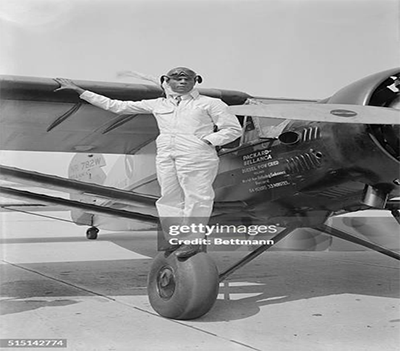Dashing and debonair, Hubert Fauntleroy Julian, the “Black Eagle,” was born in Trinidad in 1897. That was 90 years after Britain had abolished slavery, and Hubert came from a well-to-do family, which sent him to school in England. World War I caused the family to move him to safety in Montreal.
Unlike Bessie Coleman, William Powell, and James Herman Banning, Julian had no trouble finding someone to teach him to fly. He completed high school in Montreal and received his Canadian pilot’s license under the tutelage of Canadian flying ace William “Billy” Bishop. Hubert moved to Harlem, and embarked on his aviator career during the day, while being a sharp-dressing bon vivant at night. He was part of the Harlem Renaissance crowd and a vocal supporter of Marcus Garvey. He gained Mr. Garvey’s attention by flying his plane over several Negro Improvement Association parades. After those stunts, H. Allen Smith of the New York Herald dubbed him the Black Eagle of Harlem. This helped him garner financial backing for an attempt at a Trans-Atlantic flight from New York to Africa. The “Black Eagle” survived after his airplane “The Ethiopia I” crashed into the Atlantic Ocean cutting short his planned transatlantic flight to Africa.
Success arrived in 1931; he was the first Black pilot to ever fly coast to coast in the United States. Hubert also held the aviation endurance record with a non-stop flight of over 3 ½ days (84 hours). Courageously he flew multiple flights in and between the Americas, Europe, and Africa, surviving several crashes. In between, he toured with a small, all-Black flying circus which he headed, called “The Five Blackbirds.” During the Italian invasion of Ethiopia in 1935, Hubert flew to Ethiopia to aid in the defense of Selassie’s government. He was put in command of the Ethiopian air force, and is remembered for his vocal anti-fascist stance. He was an astute entrepreneur and saw the war as an opportunity to covertly sell arms to the “3rd world nations” affected by the conflict; this venture was so lucrative during the war that he continued arms dealing for two more decades. To the consternation of the F.B.I., their efforts only slowed his business, and the “Black Eagle” flew into the sunset a very wealthy man. We learned about Charles Lindbergh and Amelia Earhart, but the story of Harlem’s “Black Eagle” was lost.
Black Press: Saving Our Story
